3D Symmetry Types |
  
|
Symmetry Types. General Information
The collection of copied objects of a single operation of symmetry can contain several elements of necessarily the same time (only operations, only Bodies, only faces, etc.). The result of execution of the operation and its parameters depend on the type of the initial data of symmetry.
Symmetry of Operations
Symmetry of operations allows a user to symmetrically copy the existing operations of the model. As a result, new Bodies appear – symmetrical copies of the initial operations.
In the structure of a 3D model, the result of symmetry of operations is shown in the following way: if for creating the symmetry only one operation was selected, then the last operation of the created Body-copy will be the symmetry operation itself. On the other hand, if the symmetry was created for several operations simultaneously, then the references to the symmetry operation will serve as the basic operations of new Bodies.
Optional mode of copying with union automatically combines the created copy with the body of the source operation. If the collection of the symmetry objects contains more than one operation, then each created symmetric copy is combined with the corresponding to it source operation. This mode can be useful for designing the assemblies with large number of symmetric parts.
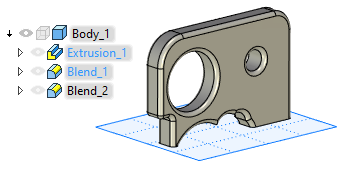
Source model
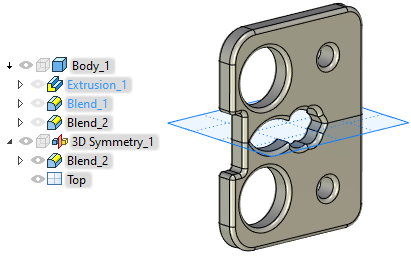
Copy without unite
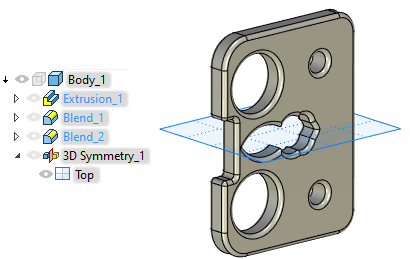
Copy with unite
3D copy of operations can work in the move mode. In this case, the body of the source operation is removed, and only created copy remains in the 3D scene and in the tree of the 3D model.
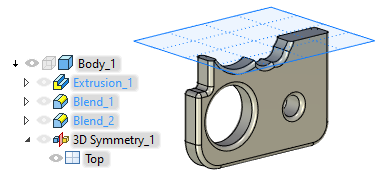
Move
Symmetry of Bodies
Symmetry of Bodes is created in the same way as the symmetry of operations. But while the symmetry of operations copies only the results of specific operations, the symmetry of Bodies copies the whole Body obtained by using the selected operation. Later when this Body is modified, the symmetry will be regenerated taking into consideration new operations entered into the Body history.
Symmetry of 3D fragments
Symmetry of 3D fragments is created in the same way as the symmetry of Bodies.
The operation gets into the model tree in the form of an item, inside which all the elements of the symmetry are fully functional fragments. This allows you to apply, for example, transformations, exploded view scenario, and other operations to selected elements of symmetry.
Symmetry of 3D Construction
The symmetry operation allows a user to symmetrically copy any 3D construction elements except workplanes and LCS. As in the previous case, in the framework of a single operation, several 3D construction elements can be simultaneously subjected to the symmetry.
In the tree of the 3D model, the created operation is put into a special folder 3D Construction > Symmetry. The elements-copies, obtained as a result of using this operation, are also put into the corresponding folders of the tree. For example, when creating the symmetry of the 3D profile, the resulting profile-copy will be put into the folder 3D Construction > 3D profiles.
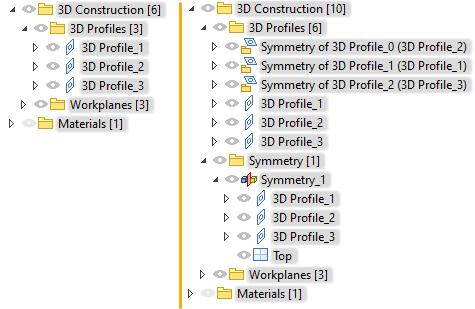
The tree of the 3D model before and after creating the 3D symmetry of construction elements
Symmetry of Faces
The symmetry of faces, as well as of the array of faces, and 3D copy of faces, allows a user to add to the bodies present in the 3D model the holes and raised portions which duplicate already existing structural elements.
All copied faces of a single symmetry operation have to belong to the same body. The outcome of creating the symmetry operation – collection of faces-copies – is included into the source body as well.
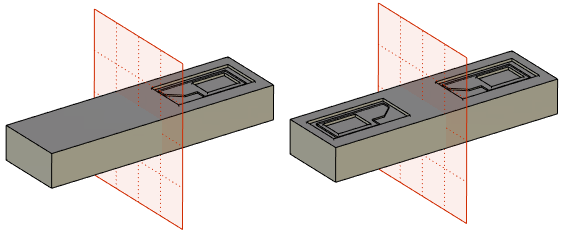
Source body and symmetry of faces result
The collection of faces selected for creating the symmetry has to fully describe the geometry of the copied structural element of the part. Faces-copies have to lie within the bounds of the source body and intersect with its other faces in the same way as the faces of the original collection.
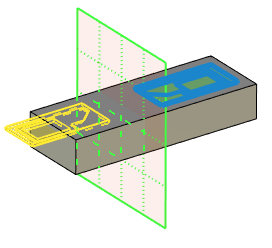
Symmetry of faces will not be created because symmetrical faces intersect the body differently compared of the original collection of faces
Specifying the initial collection of faces is carried out in the same way as in the arrays of faces by:
•Selection of closed sequence of edges bounding the desired collection of faces.
•Direct selection of all desired faces;
•Selection of the operation that created the desired collection of faces.
In addition, one more additional condition is imposed on the source collection of faces of symmetry: all edges bounding the collection of faces being copied have to belong to one “base” (not included into the list of copied faces) face of the body.
The following additional modes can affect the outcome of the face symmetry operation:
•Copying to one face. The use of this mode significantly reduces the symmetry regeneration time;
•Extend surfaces (is used only along with the mode Copying to one face). The system will automatically extend or trim the faces being copied for assuring their proper insertion into the body;
•Check intersection with other faces (is used to prevent creation of self-intersecting body).
More detailed description of these modes can be found in the chapter Arrays.